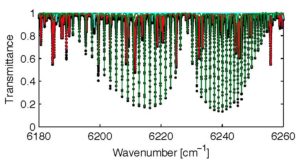
Our research group is interested in understanding links between the climate system and the carbon cycle
How will carbon sinks in the ocean and terrestrial ecosystems interact with changing atmospheric composition and climate?
How can we best use atmospheric and remote sensing observations to improve our ability to predict the evolution of the climate system on timescales of decades to centuries?
How can we employ remote sensing observations to understand global biogeochemistry?
How will human activity interact with longer-term climate changes to affect the carbon cycle?
Remote sensing observations for carbon cycle science
Remote sensing observations of atmospheric composition and land surface processes provide global information about the Earth system. Our group employs novel analysis methodology to harness these observations towards understanding underlying ecosystem processes and for testing insights from these observations against models. We use total column observations from the TCCON network, and observations of CO2, CH4, and Chlorophyll fluorescence from NASA’s OCO-2 and OCO-3 satellites to understand global carbon dynamics. We leverage observations from other NASA missions, such as SMAP and GRACE link the carbon, water, and energy cycles.

High latitude carbon exchange
The Arctic and boreal regions are experiencing more rapid climate change than anywhere else on Earth. These regions contain twice the atmospheric mass of carbon as permafrost, and these carbon stocks are vulnerable to continued warming. Moreover, increases in the atmospheric CO2 seasonal cycle show that ecosystems in the northern high latitudes are already responding to climate change. We are using atmospheric and remote sensing data to understand the drivers of high latitude carbon cycle feedbacks.
Understanding interannual variability in the carbon cycle
Almost 50% of human-emitted CO2 is taken up by the oceans or terrestrial ecosystems, although interannual variability in climate can cause short-term changes in the fraction of CO2 that remains in the atmosphere. We are investigating links between observed changes in the atmospheric CO2 growth rate, climate drivers such as temperature and precipitation, and fire — which is controlled both by climate and by human land use and land management decisions. Using both simple models with generalized surface fluxes and Earth system models, we are determining where climate-carbon feedbacks are robust and may be good predictors of long-term evolution and where more observations are needed to disentangle climate effects.

Benchmarking Earth system models against atmospheric observations
Earth system models (ESMs) predict the evolution of atmospheric CO2 concentrations based on feedbacks in ocean- and terrestrial ecosystem-carbon storage as climate evolves, tackling one of the biggest uncertainties in the extent of global climate change for a given anthropogenic emissions trajectory. We develop rigorous ways to analyze output from these models against different types of observations to determine model performance on seasonal, interannual, and decadal timeseries as part of the International Land Model Benchmarking (ILAMB) project. We also work with the Community Earth System Model (CESM), a fully coupled model, to simulate future climate-carbon interactions.
